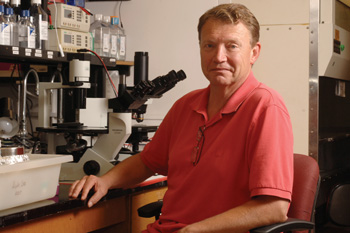
Thomas Aune, Ph.D., is studying how histones regulate gene expression. (photo by Anne Rayner)
Histone code may contain secrets to cell differentiation
The humble histones are getting more interesting. These proteins — responsible for compacting the several feet of DNA in each of our cells 10,000-fold to fit into our “cozy” nuclei — were once thought to act simply as a spool around which DNA is wound.
In recent years, scientists have proposed a grander role. By chemical modifications made to their tails, histones establish a sort of code that regulates the “what, when and where” of gene expression, in turn regulating cell function.
In the July issue of Nature Immunology, Thomas Aune, Ph.D., and Shaojing Chang report a novel facet of this “histone code” — its role in the differentiation of a subset of immune cells, the T helper cells — and the surprising dynamic nature of the responsible modifications.
“We still do not fully understand how cells differentiate,” said Thomas Aune, Ph.D., professor of Medicine and Microbiology & Immunology. “We know that the cell is essentially defined by the genes it expresses. That makes a given type of cell 'that cell' — a nerve cell, a heart cell, etc.,” he said.
The control of the timing, location and amount of gene expression is complex and not well understood. But in recent years, scientists have found that histone modifications may play an important role.
“It used to be that histones were kind of boring,” said Aune. “We've come to learn that they have a little tail that can get modified by a number of different compounds. These modifications are employed to activate or silence a gene. So what we are trying to do right now is to understand the landscape.”
To begin to understand this process, Aune turned to a set of blood cells, the T helper cells. In the body, T cells exist as “naïve” or undifferentiated cells until they encounter a pathogen or an inflammatory signaling molecule (cytokine).
That signal instructs the naïve T cell to develop into either a T helper type 1 (Th1) or a T helper type 2 (Th2) cell. Th1 cells, which produce the cytokine interferon-gamma, fight off intracellular pathogens, whereas Th2 cells target extracellular pathogens but do not produce interferon-gamma.
Aune examined the formation of modifications known as methylation marks at histone sites H3K9 and H3K27 — which are generally considered “transcriptionally negative” marks — at the gene encoding interferon-gamma.
He found that methylation at a histone site called H3-K9 appears early during the differentiation process and is maintained during Th1 differentiation. In contrast, the H3-K9 methyl mark is lost during Th2 differentiation and replaced by a second, transcriptionally negative mark — methylation at H3K27.
Although H3-K9 methylation is usually associated with transcriptionally silent genes, Aune suspects that its association with an actively transcribed gene (interferon-gamma) in Th1 cells may represent an additional level of control for the extremely important process of T cell differentiation and interferon-gamma production.
“It makes sure that you make just the right amount of interferon,” he said. “If you don't make enough interferon, you can't control the pathogen. If you make too much interferon, you may have a sepsis-like syndrome.”
Perhaps the most surprising finding was the dynamic nature of the histone marks.
“Most people have thought that once histone modifications are formed at a locus, they are static — they don't change,” Aune said. “The most novel thing about our study is that these histone modifications are dynamic.”
How histone-modifying enzymes “know” which histone sites to modify remains a mystery and an area of intense investigation — in part because of a suspected role in cancer.
“Looking at different cancers, people have found the re-expression of certain genes, and the repression of genes that are typically histone modified. People have even started to find defects in some of the histone-modifying enzymes in cancer,” Aune said.
Because of their proposed role in cancer, identifying how these modifications occur — and how they can be manipulated — might advance our understanding of cancer and improve chemotherapy.
The answers to those questions may also reveal clues about the evolution of life on Earth.
“These enzymes, and therefore these histone modifications, appeared with the development of multicellular organisms. They are not seen in single-celled organisms,” Aune noted. “So people think that this was key to our ability to differentiate into multicellular organisms and spurred evolution onward and upward.”













